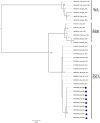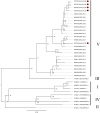Co-circulation of Chikungunya virus, Zika virus, and serotype 1 of Dengue virus in Western Bahia, Brazil
- PMID: 37680530
- PMCID: PMC10482036
- DOI: 10.3389/fmicb.2023.1240860
Co-circulation of Chikungunya virus, Zika virus, and serotype 1 of Dengue virus in Western Bahia, Brazil
Abstract
Chikungunya, mayaro, dengue, zika, and yellow fever are mosquito-borne viral diseases caused, respectively, by Chikungunya virus, Mayaro virus (CHIKV and MAYV, respectively: Togaviridae: Alphavirus), Dengue virus, Zika virus, and Yellow fever virus (DENV, ZIKV, and YFV, respectively: Flaviviridae: Flavivirus). These viruses have an important epidemiological impact worldwide, especially in Brazil. Western Bahia is one of the less studied regions in that country regarding the circulation of these pathogens. In this study, we aimed to apply molecular biology assays to better know the mosquito-borne viruses circulating in Barreiras and Luís Eduardo Magalhães, two main cities of Western Bahia. From March to June 2021, we enrolled 98 patients with the clinical diagnosis of dengue. Personal information (gender and age) were retrieved at the moment of enrollment. Serum samples were obtained from volunteers and used in molecular detection of CHIKV, MAYV, DENV, ZIKV, and YFV by reverse transcription followed by real-time polymerase chain reaction as well as in genome sequencing aiming phylogenetic analysis. As the main result, we found that from the 98 patients 45 were infected by CHIKV, 32 were infected by serotype 1 of DENV (DENV-1) and six were infected by ZIKV, while 15 were negative for all arboviruses tested. In addition, phylogenetic analysis revealed that all CHIKV-positive samples were of the East/Central/South African (ECSA) genotype, while all DENV-1-positive samples were of the V genotype. These results clearly show that epidemiological surveillance cannot be based only on clinical evaluations. Laboratory diagnosis is important in arbovirus infection that are prevalent in a particular area. These findings also demonstrate the co-circulation of many arboviruses in Western Bahia in 2021.
Keywords: RT-PCR; Western Bahia; arbovirus; co-circulation; phylogeny.
Copyright © 2023 de França Cirilo, Pour, de Fatima Benedetti, Farias, Fogaça, da Conceição Simões, Vidal, Birbrair, de Andrade Zanotto, Luiz and Amorim.
Conflict of interest statement
The authors declare that the research was conducted in the absence of any commercial or financial relationships that could be construed as a potential conflict of interest.
Figures



References
-
- Andrews S. (2010). FastQC: A Quality Control Tool for High Throughput Sequence Data. Available at: ww.bioinformatics.babraham.ac.uk/projects/fastqc
-
- Areas with Zika | Zika virus | CDC (2016). Available at: http://www.cdc.gov/zika/geo/ (Accessed March 15, 2016).
LinkOut - more resources
Full Text Sources
Research Materials

